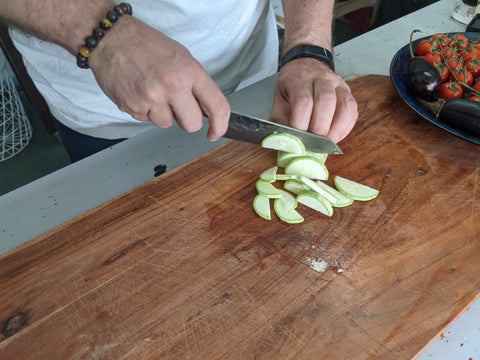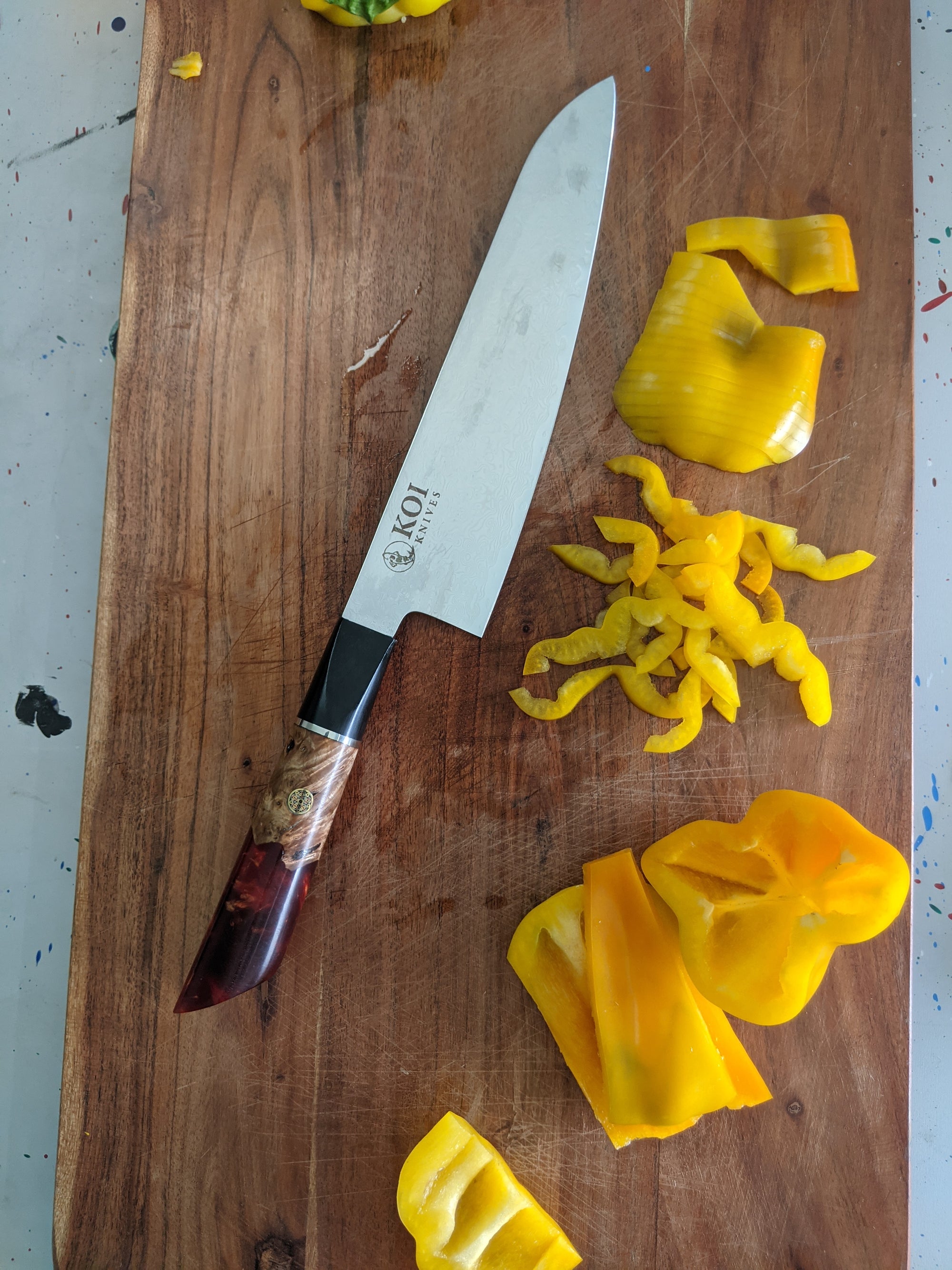The Top Five Best Japanese Knives for Cutting Vegetables

Whether you are the strict and ‘puritanical’ vegetarian or a foodie who gobbles up pretty much everything under the sun, veggies will often be an integral part of your diet. They are both delicious and nutritious but the devil is always in the prep work. Without a good knife and technique, your workspace might look like a warzone by the time you are done prepping your veggies.
Even for the seasoned cook, prepping veggies is always a cumbersome and messy job, sometimes fraught with injuries. So many people leave veggies out of their diets simply to avoid the elaborate process required to prep your vegetables right from the washing to chopping and cooking. Vegetables also leave behind plenty of mess such as the peels, stalks and so forth. Vegetable prep work can get even more needlessly difficult if you don’t possess the right Japanese kitchen knives for vegetables in your arsenal.
Having the right knife type for cutting or chopping vegetables simplifies the prep work, making it a lot more efficient, less messy and easier. A good vegetable knife also shears off much of the downtime involved in the prep work. With a good vegetable cutting knife in your toolbox, you might find yourself including more vegetables in your diet because the prep work will be a complete breeze and something that you will actually be looking forward to. That also means a healthier and more balanced diet. A good vegetable knife can therefore make a world of difference, not just in your cooking but also in your overall health and lifestyle. The fun of it all might even ‘convert’ you into a full-fledged vegetarian, indulging in some of the healthiest and most delicious vegetarian recipes.
Shopping for a Vegetable Knife
There are a lot of factors that a home cook or professional chef should put into consideration when shopping for a vegetable knife. Key amongst these is the type of vegetable you are planning to cut, chop or slice. For example, are you looking for a knife for the leafy green vegetables or the tough-skinned vegetables such as squash?
Consider, too, the sharpness and the size of the knife. You ought to pick the right size of a Japanese kitchen knife that will match the size of your hand and workspace.
There is a large spectrum of knife sizes for veggies so determine what will suit your needs best when shopping for one. You should also go for the wide-bladed knives, particularly if you are planning to cut the larger produce. A wider knife blade enables you to easily glide through the larger farm produce using a quick swipe of the knife. If you have a smaller blade width, chances are that the blade will get stuck half way in the produce. A wider knife blade also serves the secondary function of helping you scoop the veggie pieces and strips that you have cut and sliding them directly into your salad or soup.
Finally, consider the material used in the blade. Most Japanese kitchen knives are made from harder steel such as carbon steel or forged steel which has excellent edge retention.
Below is a roundup of some of the best Japanese knives for vegetables with which you can chop, dice, slice or cut just about any vegetable in your kitchen.
Santoku

The sheepsfoot-style santoku knife is more generally a multipurpose kitchen knife. It is a “three virtues” kitchen knife that you can use to cut fish, meat and vegetables.
In fact, both home cooks and professional chefs will use the santoku knives mostly for their fruits and vegetables than on fish and meat. So as a vegetable knife, the santoku will be your top kitchen workhorse. You will use it to dice the carrots and onions, slice your tomatoes and mince your garlic among other veggie-based uses.
The knife is lightweight, thin and easy to hold so you can comfortably use it to make precision cuts on your fruits.
The santoku knife also features a slight belly that enables you to use the knife in a rocking motion when you are slicing your vegetable strips.
The edges of the santoku knife may also be scalloped. This is more commonly referred to as a “Granton” edge and it contains small indentations that let in little pockets of air between the blade and the ingredients you are slicing, thereby preventing these ingredients from sticking on the surface of the blade after every slice.
The santoku knife is particularly effective in slicing tomatoes and carrots. You can also use it to make delicate knife cuts on your veggies such as brunoise or dices.
When used in slicing tomatoes, the santoku knife will rapidly bite into the relatively hard and slippery surface before quickly sliding through the soft tomato flesh without crushing the fruit.
You can also use the santoku to slice or dice your onions or to cut your carrots into different pieces including rondelle, dices, thin rounds, long sticks or brunoise.
The santoku knife can also be used on cucumbers, herbs, garlic and zucchinis.
The santoku might be a versatile vegetable cutter but its lightweight and smaller size may not be suited for the larger and denser ingredients. For that, you will need a….

Here is a specialty blade that’s specifically designed for cutting greens. In fact, the name ‘nakiri’ itself means “leaf cutter” in Japanese.
The nakiri knife is a traditional Japanese-style vegetable knife. It is a single-bevel kitchen knife with a rectangular profile and straight blade edge that will cut all the way through to the board without having to pull or push horizontally.
It is a thin and tall blade with excellent knuckle clearance so you can use it to chop your vegetables repeatedly without worrying about injuries to your knuckles. In Japan, the nakiri knife is commonly used to quickly and efficiently chop, slice or mince vegetables. In many Western kitchens, it is becoming a top favorite with vegetarians.
The nakiri knives with Japanese-style handles have the balance point of the knife tilted more towards the tip of the knife, giving the nakiri knife excellent nimbleness and precision.
The straight and flat blades of the nakiri knives are obviously not suited for the push and pull rock chopping methods like their gyuto or Western-style chef’s knife counterparts. But you can use the nakiri knife to process all vegetables ranging from the leafy greens to the tough-skinned vegetables such as squash and eggplants. However, the ultra-thin-edged blade nakiri knife won’t give you the kind of versatility that you would get with a santoku or gyuto kitchen knife. Use them only on vegetables but don’t use them on fish, meat or bones.

Like the santoku and the gyuto, the bunka knife is a general-purpose kitchen knife. However, it is not as commonplace as the other two.
Like the nakiri, the bunka is a specialty Japanese vegetable knife. It is easily recognizable by its very wide blade that is suited for cutting or chopping vegetables and even scooping them into your kitchen bowl. However, the bunka knife also features a triangular tip that is suited for cutting or scouring meats and fish.
The bunka knife has lots of similarities with the santoku knife, apart from its triangular tip. As a veggie cutter, it doesn’t give you the kind of versatility that you would get with the nakiri knife. If you are looking for an all-purpose veggie cutter that you can use on all kinds of vegetables including the tougher skinned veggies, you’d be better off with the nakiri knife.

Like the santoku, the gyuto is general-purpose kitchen knife that you can put into just about any kitchen task including cutting, dicing and chopping your vegetables.
The gyuto is the Japanese take on the classic Western chef’s knife but it is much thinner and lighter. Also, unlike the santoku with its sheepsfoot design and flat tips, the gyuto has a pointed tip.
The gyuto has a profile that is flatter towards its heel that is ideal for chopping. It also exhibits a gradual curve towards the tip of the knife that allows you to use it in a rocking motion. It is therefore a very versatile vegetable cutting knife that you can use with a variety of vegetables. Add the fact that it is lightweight, thin and comfortable to wield and you begin to get why this is another indispensable kitchen workhorse for your vegetable cutting needs.
It is also a double-bevel knife so you won’t have to struggle with mastering this knife. Wielding it and using it to slice, dice and chop your vegetables will come almost naturally. It’s very much like the Western-style chef’s knife except that it is lighter and thinner.
You’d certainly want to have the gyuto in your kitchen if your vegetable cutting tasks encompass a large variety of veggies. You can use it with everything from leafy greens to carrots, squash and potatoes. However, if you handle the larger and tougher skinned vegetables, we would recommend the nakiri knife rather than the gyuto. But this is a great multipurpose vegetable cutting tool to have in your arsenal.

This baby kitchen knife is also an impeccable vegetable cutter and fruit peeler. Paring knives are available in a variety of shapes and sizes so you will have to factor that in depending on the uses that you have in mind.
The general-purpose paring knife is usually the straight-edged and sharp-tipped variant that comes in handy for your general-purpose slicing and paring work.
There is the paring knife with a bird’s beak shape, slightly curved and suited for peeling citrus or fruits.
The sheepsfoot paring kitchen knife or the flat paring knife is a bit longer and also larger than a spear point paring knife. It is suited for slicing or paring small veggies such as ginger, shallots and garlic.
Use the straight-edged paring knives for tasks such as peeling, pairing or slicing the smaller vegetables. This is the kitchen knife that you go to if you want to quickly thinly slice your cucumber or top up your gazpacho. You can also use this paring knife to cut your apples when you are having fruit on a picnic. Make use of the small blades of the straight-edge paring knives to peel your veggies or fruits.


